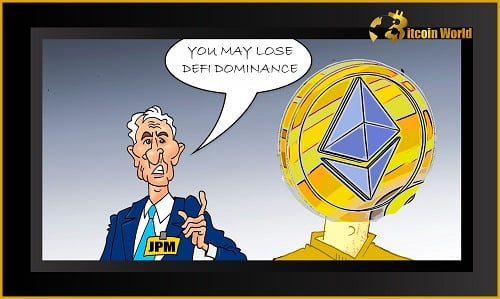The world of Decentralized Finance (DeFi) is constantly evolving, and a recent analysis from JPMorgan suggests a potentially significant shift in power. According to a report by Nikolaos Panigirtzoglou, Managing Director of Global Markets Strategy at JPMorgan, Ethereum’s long-held supremacy in the DeFi arena might be facing serious headwinds. The core concern? Scaling issues. Let’s dive into what this means for Ethereum and the broader DeFi landscape.
The Scaling Hurdle: Is Ethereum’s Dominance at Risk?
Panigirtzoglou’s report highlights a critical challenge for Ethereum: scaling. The network’s ability to handle increasing transaction volume and maintain its leading position in DeFi is being questioned. The report states that:
“Which is necessary for the Ethereum network to maintain its dominance, might arrive too late.”
This is a stark warning. For a long time, Ethereum has been the undisputed king of DeFi. Think of it as the foundational layer upon which a vast ecosystem of decentralized applications and financial instruments has been built. However, like any growing city, Ethereum is experiencing growing pains – congestion and high fees, particularly during peak usage. These issues stem from its Layer 1 blockchain architecture.
Ethereum’s solution to this? A Layer 2 (L2)-centric roadmap. This strategy promotes the use of rollups and sidechains. Imagine L2 solutions as express lanes built alongside the main highway (Layer 1). They are designed to handle transactions more efficiently and at lower costs, relieving pressure on the main network. While this is a promising approach, the report suggests it might not be enough, or at least, not fast enough.
The DeFi Landscape Shift: Ethereum’s Market Share Decline
At the beginning of last year, Ethereum’s dominance in DeFi was near absolute, estimated to be around 100%. Fast forward to today, and that figure has reportedly dropped to approximately 70%. This isn’t just a minor dip; it signifies a real shift in the DeFi landscape. But where is this market share going?
The Rise of ‘Ethereum Killers’: A Real Threat?
Here’s where things get really interesting. According to Panigirtzoglou, Ethereum isn’t just losing ground to its own L2 scaling solutions. Instead, a significant portion of its lost DeFi market share is going to alternative blockchain networks, often referred to as “Ethereum killers.” These networks, including Solana, Avalanche, Binance Smart Chain (BSC), and Terra, are gaining traction and building their own vibrant DeFi ecosystems.
What makes these “Ethereum killers” so compelling?
- Faster Transactions & Lower Fees: These networks often boast significantly faster transaction speeds and lower fees compared to Ethereum’s Layer 1. This is a major draw for users and developers alike, especially for those priced out of Ethereum due to high gas costs.
- Growing Communities: Each of these networks is actively building its own community of developers, users, and investors. This growing ecosystem effect fuels further innovation and adoption.
- Native Token Performance: The native tokens of these networks (SOL, AVAX, BNB, LUNA) have seen impressive price appreciation, outperforming ETH in the past year. This reflects the growing investor confidence and market interest in these alternative platforms.
Let’s take a closer look at some of these key competitors:
| Blockchain | Key Features | DeFi Focus |
|---|---|---|
| Solana (SOL) | High throughput, low fees, Proof-of-History consensus | Speed and scalability for high-frequency DeFi applications |
| Avalanche (AVAX) | Subnets for customizable blockchains, fast finality | Institutional DeFi, scalability, and interoperability |
| Binance Smart Chain (BSC) | EVM-compatible, lower fees, centralized exchange backing | Accessibility and lower barrier to entry for DeFi users |
| Terra (LUNA) | Algorithmic stablecoins, focus on payments and e-commerce | Stablecoin-centric DeFi ecosystem, payments infrastructure |
These networks are not just copies of Ethereum; they are innovating and offering unique value propositions within the DeFi space, attracting users and projects seeking alternatives to Ethereum’s limitations.
Ethereum 2.0 and Sharding: The Long-Term Solution?
Ethereum is not standing still. The highly anticipated Ethereum 2.0 upgrade is a multi-phased initiative designed to address scaling challenges and transition the network to a more sustainable future. A key component of Ethereum 2.0 is the shift from a Proof-of-Work (PoW) consensus mechanism to a more energy-efficient Proof-of-Stake (PoS) consensus, known as “The Merge.” This transition is expected to significantly improve energy efficiency and lay the groundwork for further scaling improvements.
However, the ultimate scaling solution for Ethereum’s Layer 1, known as sharding, is still on the horizon and is not expected to arrive until next year. Sharding will essentially divide the Ethereum blockchain into multiple shards, allowing for parallel processing of transactions and a massive increase in network capacity.
The Race for DeFi Dominance: An Uncertain Outcome
As Panigirtzoglou’s note concludes:
“In other words, Ethereum is currently in an intense race to maintain its dominance in the application space with the outcome of that race far from given, in our opinion.”
This encapsulates the current state of DeFi. Ethereum is in a race against time and competition. While Ethereum 2.0 and L2 solutions hold immense promise, the rise of alternative Layer 1 blockchains is undeniable. The outcome of this race will shape the future of DeFi and determine which platforms will lead the next wave of decentralized innovation.
Will Ethereum successfully scale and reclaim its dominant position? Or will “Ethereum killers” continue to chip away at its market share and forge a more multi-chain DeFi future? Only time will tell. One thing is certain: the competition is heating up, and the DeFi space is becoming more dynamic and diverse than ever before.

Related Posts – Ex-SEC Chair, Jay Clayton Believes Cryptocurrency Industry Is For Long Haul
Disclaimer: The information provided is not trading advice, Bitcoinworld.co.in holds no liability for any investments made based on the information provided on this page. We strongly recommend independent research and/or consultation with a qualified professional before making any investment decisions.


